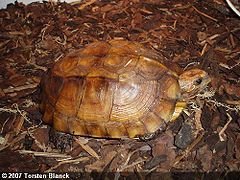Keeled box turtle
| Keeled Box Turtle | |
|---|---|

| |
| Keeled box turtle Pyxidea (Cuora) mouhotii mouhotii | |
| Scientific classification | |
| Kingdom: | |
| Phylum: | |
| Class: | |
| Order: | |
| Suborder: | |
| Superfamily: | |
| Family: | |
| Subfamily: | |
| Genus: | Cuora (but see text)
|
| Species: | C. mouhotii
|
| Binomial name | |
| Cuora mouhotii | |
| Synonyms | |
|
Pyxidea mouhotii (but see text) Cyclemys mouhotii | |
The Keeled Box Turtle (Pyxidea mouhotii) is a species of the turtle family Geoemydidae found in China (Hainan & southwestern Guangxi and possibly southern Yunnan), northern and Central Vietnam, Laos, northern Cambodia, Thailand, Myanmar and Assam in India.
Taxonomy
It is either the only species within the genus Pyxidea, or the latter is included in the other genus of Asian box turtle, Cuora. Genetic analysis by Stuart and Parham (2002), Parham et al. (2004) and Spinks et al. (2004) have shown, that this species is very closely related to the Genus Cuora. Depending on each scientist's taxonomic view, it can now be regarded as a species of Cuora or well still remain as a Genus or subgenus i.e. Pyxidea. Since Pyxidea is the commonly used name for this species, it will be maintained as such here.
One subspecies has been described so far:
- Pyxidea (Cuora) mouhotii obsti (Fritz, Andreas & Lehr, 1998) from the Annam mountain range in central Vietnam. It is distinguisehd by the nominate subspecies by its rounder shell, an reticulated head pattern and a distinct plastral pattern with more black pigments (forming larger black blotches).
- The Populations from Myanmar and India might represent another yet undescribed subspecies.
Description
This turtle is characterized by a yellowish brown to darkbrown or even black colored carapace, with a distinctive keel running lengthwise down the center of it, and a yellowish, orange, red, brown or black head and limbs. It is not as aquatic as the typical species of Cuora but rather terrestrial, preferring only moderately moist habitats with plenty of vegetation and ground litter for cover. They grow to approximately 7 inches in length and are mainly carnivorous, some accepting fruits in captivity.
Females of the Indochinese Box Turtle complex hybridize - apparently in the wild - with Keeled Box Turtle males to produce the turtles once considered a separate species or subspecies Cuora (galbinifrons) serrata.[1] see Cuora on this topic.
Footnotes
- ^ Parham et al. (2001), Buskirk et al. (2005).
References
- Template:IUCN2006 Listed as Endangered (EN A1d+2d)
- Bernhardt, K. (1995): Pyxidea mouhotii (Gray 1862). J. AG Schildkr. Panzerechsen 95(2): 7-18.
- Buskirk, James R.; Parham, James F. & Feldman, Chris R. (2005): On the hybridisation between two distantly related Asian turtles (Testudines: Sacalia × Mauremys). Salamandra 41: 21-26. PDF fulltext
- Gray, J.E. (1862): Notice of a new species of Cyclemys from the Lao Mountains, in Siam. Ann. Mag. nat. Hist 10(3): 157
- Gray, J.E. (1864): Observations on the box tortoises, with the description of three new asiatic species. Ann. Mag. Nat. Hist. 13(3): 105-111
- Parham, James Ford; Simison, W. Brian; Kozak, Kenneth H.; Feldman, Chris R. & Shi, Haitao (2001): New Chinese turtles: endangered or invalid? A reassessment of two species using mitochondrial DNA, allozyme electrophoresis and known-locality specimens. Animal Conservation 4(4): 357–367. HTML abstract Erratum: Animal Conservation 5(1): 86 HTML abstract
- Stuart, B.L. & Parham, James Ford (2004): Molecular phylogeny of the critically endangered Indochinese box turtle (Cuora galbinifrons). Molecular Phylogenetics and Evolution 31(1): 164-177. doi:10.1016/S1055-7903(03)00258-6 PDF fulltext
External links

